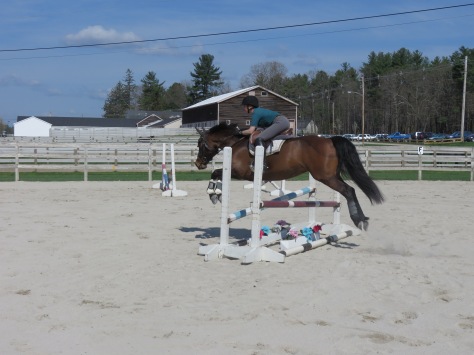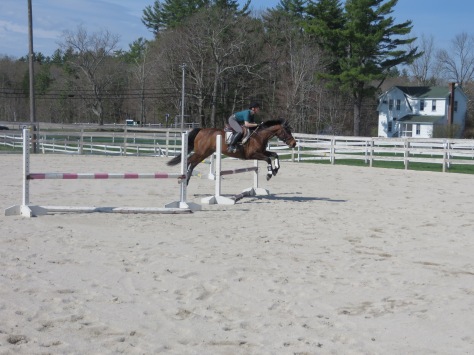Blogger’s Note: I am grateful to be a recipient of a 2015 Area I USEA eventing scholarship. In my application, I indicated that this year may be one in which I focus more on training than on competing in the sport, and I asked for funds to help cover the expenses of training sessions with both eventing and dressage experts. My recent ride with Nancy Guyotte was included as one of these training sessions. I would like to thank the scholarship committee for awarding me with this funding and I hope that this blog will help to share some of my experience with others who are interested.
I recently had the opportunity to ride once again with Nancy Guyotte, an alumna of the University of New Hampshire Animal Science program, who returned to give a clinic for the UNH Equine Program at the end of the spring semester, 2015. After working on my own for most of the winter, I welcomed the opportunity for some feedback and fine tuning from such an experienced coach.

One of Anna’s qualities, which can be simultaneously both helpful and frustrating, is that she is by and large “ho-hum” about most things. New events and activities are not necessarily worthy of great energy or reaction. This is a wonderful attribute in that you can be confident that most of the time she will remain sane and sensible. However, she has never been one who has had a strong response to any of the forward aids, meaning that it can be incredibly difficult to get and to keep her in front of the leg.
None of us want to be “that rider”, the one who goes around kicking and thumping ineffectively on their horse’s sides, nor do we want to have to use the whip constantly. We all know that, theoretically at least, we are supposed to use “light” and “invisible” aids. But doing this is only possible when the horse has been properly conditioned to respond to these cues, which means that we as riders must be able to administer our aids precisely and accurately and then release them immediately, without nagging or holding too long. Here is where riding well is simultaneously a skill and an art.

I asked to ride privately with Nancy this time because I have found that in clinic settings I am often riding with people whose horses have the opposite problem of mine—they need to be slowed or steadied, as opposed to moved forward. The clinician then spends most of the session working on exercises which bring the horse back to the rider. With Anna, the response to “whoa” is pretty good, especially when she is already behind the leg. So when you do exercises such as, for example, halting in between two fences in a line, Anna only becomes more and more sucked back, and usually she begins to stop. What I needed in this session were exercises that asked my horse to go forward and which improved the timing and accuracy of my “go” aids. I know that I am not alone in this, so if you ride a sometimes lazy and unmotivated horse, perhaps some of Nancy’s exercises will help you, too!
In watching Anna warm up, Nancy immediately noticed that she lacked suppleness and was reluctant to stretch through her topline and to let those muscles swing. These issues can be difficult to improve on when the horse is reluctant to move forward. Nancy suggested that there are two ways to help motivate a lazy horse during the warm up: first, go into a canter in two point sooner rather than later and do many forward and back transitions within the gait; second, do lots of transitions between slower gaits (like walk and trot), asking once and if the response is lackluster, using the aids really strongly and then immediately letting them go. It is important to remember in either of these exercises that the response to the downward aids must also be immediate. The goal is that the horse responds quickly to either the “go” or to the “whoa” aids. Further, one’s application of these aids ideally becomes less and less yet creates a greater response.
We tried each of these approaches with Anna, and the improvement was excellent. One of the most critical pieces of guidance Nancy offered was to not worry so much about the position of the horse’s neck during the transitions. At this point, being above the bit is acceptable. As the horse becomes more forward thinking and their suppleness increases, they will also become softer in the topline and more willing to seek the contact. This then creates the roundness in the transitions. In general, I needed to keep Anna’s neck straighter and to use more outside leg on the turns in order to keep the connection correct.
I admit that I was a bit skeptical of the’ transitions between slower gaits’ exercise. It has always been counterintuitive to me to come all the way to the walk and then to ask the horse to go forward, since the walk by definition lacks impulsion. The other thing with Anna which has been challenging is her utter lack of concern regarding the whip. Most young horses that I have worked with are aware of the whip and most respond to its presence alone by increasing their speed; it is only over time and use that they become desensitized to it, hopefully in a positive way, one which results in their appropriate response to its use. To say that Anna is unimpressed by a whip is an understatement; even the very first session that I carried one with her resulted in a minimal response. It takes a significant amount of application before its use elicits any response at all; to “tickle” her with the whip is not a useful technique. So when you decide to use the whip to back up your leg aid, the timing of its use is critical, and you have to commit to getting a response. Years ago, when I was a working student for Lendon Gray, she said it was far more humane to make your point once and be done than to nag a horse with your aids. This is certainly the case with Anna and the dressage whip.
So what Nancy really had me work on improving through the use of the transitions exercise is the timing of my aids in the transitions. No sooner had the transition been made than we were working on the next one. For the first several transitions, Nancy had me take both reins into one hand and use the whip strongly behind the leg, but then immediately let go. It is the letting go that is the hardest part of the transition, I think. I find that I want to keep supporting or squeezing with the leg aids, even if the response was good, instead of expecting Anna to carry me forward. But the other place in which it is possible to hold for too long, and therefore dull the horse’s response, is in the downward transition. This might be in the use of the rein aids, which would seem fairly obvious, but also in the use of the seat. If you want your horse to maintain their energy through the downward transition, be sure that you aren’t inadvertently holding too much with the seat. Check to see that your hips and lower back still flow and that you aren’t gripping with any muscles that need to stay soft. I know all of these things, and I thought I was doing a pretty good job in executing them, but Nancy reminded me that we are always working to be even better and even faster. The trick for me was figuring out how to be faster at releasing without releasing so much that I was dropping the aids all together.

We also worked on a variation within the warm up, taking advantage of Anna’s ability to do clean flying changes. After doing some forward and backs in the canter, we then started riding a half circle back to the track with a flying change at the end, followed by a transition forward and back within the canter to another half circle to the rail and flying change in the other direction. The half circles were smallish, between 12 and 15 meters. The purpose of this exercise was twofold: first, to get Anna thinking faster by making a series of changes in gait, direction and balance and second, to improve the turning from the outside aids.
Once we began the actual jumping work, Anna was staying reliably in front of my leg and therefore the exercises felt easy and do-able. As always, it is impossible to adjust a canter that is not forward thinking, so any attempts to manage timing at the fences are futile without a forward thinking canter. I think this session was a good reminder of the fact that horses don’t usually have jumping problems so much as they have canter problems. When you improve the quality of the canter, you then improve the quality of your performance over fences.
At one point, Anna had become so forward that she was starting to motorcycle a bit around corners and turns. To address this, Nancy had me work on another exercise which combined turning, transitions and improving the responsiveness to the aids. Starting on the long side in the canter, I rode a transition to the walk and then immediately rode a turn on the haunches followed by a canter transition in the new direction. Again, the purpose at this time was not to execute a flawless, round, dressage test worthy turn on the haunches but rather to improve the responsiveness to the outside aids as well as increase the suppleness through the inside rib cage. We progressed to riding the whole exercise in the canter, so the half turn on the haunches became a small circle around the inside leg with a flying change at the rail.
This exercise clearly showed me that Anna is stronger on her left hind than her right, as the turns flowed more easily with the left hind as the strike off phase of the canter stride. I would never have thought of using this kind of exercise to improve her jumping work, even though I am familiar with it. I would have assumed that because she isn’t reliably in front of the leg and that the quality of her gaits and connection while doing this exercise would not be good, that it wouldn’t be an appropriate exercise for her at this time.
I was reminded, yet again, that sometimes you have to use the exercises and movements themselves to help to teach the horse how to do them. Even if the execution is not perfect, or the horse isn’t “round enough”, sometimes it is helpful to use the exercise as a tool and then you can improve the details later. I remember working with another clinician, Verne Batchelder, with Lee some time ago. Lee has always struggled with connection issues, and he said that there were many trainers who would just keep her on a 20 meter circle until the connection improved. His philosophy was to use movements, and to allow the connection to develop as it would through the use of those movements. Verne said that otherwise what you end up with is a fifteen year old training level dressage horse who can only do twenty meter circles. His point was that sometimes to get to where you want to go, you have to take another way around.
This particular session left me with new ideas and new inspiration to take back to the laboratory to experiment with. I will definitely be working to discipline myself to do less with the leg and to be quicker in the timing with my aids.


